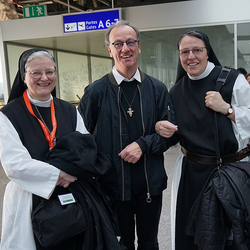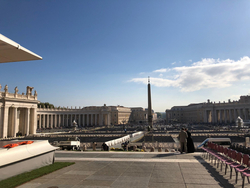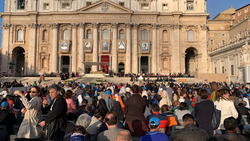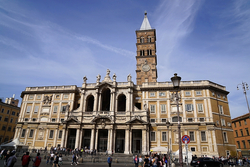Canonisation of Margaret Bays
Twenty-four years after her beatification by Pope John Paul II, Marguerite Bays was recognised as a saint by Pope Francis on Sunday 13 October 2019 at a grand celebration in Rome. The Vatican recognised the second miracle earlier this year, paving the way for canonisation.
For the occasion, Saint Marguerite Bays had delegations from Glâne, Fribourg, the canton and the federal government travel to Rome to experience this important moment.
Homily of Mgr Kurt Koch
Marguerite Bays :
A saint of love of God and neighbour
Cardinal Kurt Koch
The saints as signs of God
From time immemorial, people have looked for signs to interpret their lives and understand their place in the world. In today's Gospel we learn that Jesus gave the people of his time a clear sign, which they certainly understood immediately: the sign of Jonah, the prophet whom God sent to Nineveh to make the inhabitants repent, and who spent three days in the belly of a fish, becoming a prefiguration of Jesus Christ, who spent three days in the grave before rising from the dead. The sign of Jonah is therefore the sign that points to the deepest mystery of the Christian faith, namely the death and resurrection of Jesus Christ.
Consequently, all persons who by their lives embody this sign become living signs. This is particularly true of Saint Margaret Bays, whose grateful memory has brought us together today on the occasion of her canonization. She became a living sign because she was associated in a special way with the suffering Christ, experiencing in her body and spirit the sufferings of Jesus in Gethsemane and on Calvary, and receiving the five visible stigmata of the Crucified One which brought her much torment. She also shared in the cross of Jesus because of her difficult family situation, especially because of one of her sisters-in-law who subjected her to many humiliations.
St. Margaret bore these various sufferings in her deep faith, specifically by taking part in the daily celebration of Holy Mass, which was for her the high point of her day, in Eucharistic adoration, by walking the Via Crucis on Sundays after Holy Mass, by praying the Rosary daily and by making numerous pilgrimages to Marian shrines. Thus she did not spend her life in a monastery, nor in any other religious community, but in the world. She earned her living as a seamstress. This is how she became a saint, as the parishioners of Siviriez had already declared on 27 June 1879, the day of her death: "Our saint is dead". In this way she showed us and still shows us today what it means to become a saint and to be a saint.
Access to holiness: a common destiny for all people
In the life and death of St. Margaret, we can see first of all what sanctity means in the Christian faith. For her, sanctity had nothing to do with heroism and sensationalism, nor even with the stigmata that she was careful to hide from the curious. Rather, sanctity is hidden under the veil of the most trivial aspects of everyday life. The simple, neutral everydayness of her love for Christ and her neighbour was her vocation to holiness. His life shows us what holiness in the biblical sense means. For in his first letter to the Thessalonians, to the most basic question of the Christian faith - what is the will of God? - Paul gives an equally basic answer: "The will of God is your sanctification" (4:3).
By this Paul means that the will of God in its essence is quite simple and the same for each of us, namely holiness. The Christian vocation to holiness is not elitist, but absolutely egalitarian. Nowhere is the democratic equality of all members of our Church more fully realised than in the quest for holiness. For for God, to be holy is not what is extraordinary, but rather what is usual and normal for every Christian. Christian holiness does not generally consist in inimitable heroism, but in the ordinary life of the Christian in God.
All Christians are called to such holiness. St Margaret lived out this conviction of faith, anticipating what the Second Vatican Council recalled by giving great importance to the "universal vocation to holiness". The entire fifth chapter, and therefore the heart of the Church's Dogmatic Constitution "Lumen Gentium", is dedicated to this guideline for Christian life: "It is therefore evident to all that the call to the fullness of Christian life and to the perfection of charity is addressed to all who believe in Christ, whatever their state or form of life; in earthly society itself, this holiness contributes to promoting more humanity in the conditions of existence."
Not copies, but unique examples of holiness
Holiness is not a luxury and the privilege of a few; it is the destiny of all. Every Christian is called to follow his or her own path to holiness. Four hundred years ago, St. Francis de Sales, the illustrious bishop of Geneva, already expressed this conviction of faith in these words: "A bishop should not and cannot live like a Carthusian and couples like Capuchins. Artisans are not contemplative religious who pray half the day and night... Each in his own way. The Christian vocation to holiness is realised in countless forms and can be lived in all states and professions.
Therefore, the Christian vocation to holiness does not mean simply imitating or copying great saints; it is meant to be realised in each life that is unique and not interchangeable. God does not want Christians who strive for holiness to be copies, but originals, as Pope Francis magnificently emphasises: "What is important is that each believer discerns his or her own path and brings to light the best in him or her, what the Lord has deposited in him or her that is truly personal (cf. 3] For the living God has given each of us, in our own way, the opportunity to achieve holiness, as the history of the Church shows us with its many saints, each distinguished from the other by the uniqueness of his or her human personality and spiritual charism.
If we delve into the Scriptures, we encounter another facet of Christian holiness. It does not presuppose that one has never made a mistake, nor that one has never committed a sin. Even the holy apostles did not 'fall from heaven', they were people like us, with their strengths and weaknesses. Jesus called them, not because they were already saints, but so that they might become saints. The Scriptures thus contain a wisdom of life, as Gilbert Chesterton said: "You can tell a saint by his consciousness of being a sinner.
Sharing in the holiness of God
Christian holiness is not the opposite of sin but grows with the capacity for conversion. A saint is indeed recognised by the knowledge that he or she is a sinner, but also by the fact that he or she lives in the consciousness of the believer who knows that there are no "hopeless cases" for God, but that God offers everyone the possibility of starting again. To live in such trust in God is already Christian holiness. In ordinary daily life in God, living with him, reaching out to him and shaping one's life in a spirit of faith, is what makes Christian holiness visible, as it did in the life of St. Margaret Bays.
Of course, she showed us another side of holiness: to become holy and to be holy means to realise fully what we already are. Such a phrase may sound strange at first, but it expresses the most important message of our faith, namely that we cannot sanctify ourselves, but that we are sanctified, that we have already been sanctified by our baptism. In the Scriptures, all the baptised are described as 'saints', not because they are immaculate and will not make mistakes. In reality, the baptised are holy because they have been sanctified by Christ in the sacrament of baptism.
To conclude, we can ask what a holy man is and read the answer in the preface of the saints, in which it says: "You are glorified in the assembly of the saints: when you crown their merits, you crown your own gifts." Therefore, when we speak of holy persons, we are necessarily speaking of God. For only God is holy and human beings can only become holy by being fully rooted in God and transparent to him. A saint is a human being who places the true and immense desire of his or her heart entirely in God, who is limitless, and whose concern is to honour God with his or her life. A saint is a person who is so open and ready to welcome God that God can truly come to him and be welcomed, that his coming can take place.
When we venerate a saint, we honour God, and then we praise him, more precisely we praise God's final coming and his victorious advent in that person. The Catholic practice of venerating the saints is in the full sense of the word the worship of God and the culmination of the unity between the love of God and the love of neighbour. By venerating a saint and confidently asking for his or her intercession, we love God in him or her because he or she knew how to accept him or her fully and was therefore benevolent towards man.
The great theologian Origen said in the third century that the love of the saints for their neighbours does not diminish when they have passed into the other world. Because they are even closer to God, they are even closer to people. This certainly applies to St. Margaret Bays, who was so intimately connected with God in her life that she sought and found God also in human beings and showed them his loving intercession. This unity of love for God and neighbour, which characterised her in her earthly life, she continues to nourish in God's eternity.
In this certainty, we ask Saint Margaret Bays to intercede with the living God so that he may give us the strength and courage to immerse ourselves ever more deeply in the mystery of the life of this saint, to give thanks to God for the gift of holiness that he offered us in baptism, and to rediscover and deepen intimately our personal vocation to holiness, so that we too, like Paul in today's reading, may welcome the saints who have been called: "Grace and peace from God our Father and the Lord Jesus Christ. " Amen.
Lesung: Röm 1, 1-7
Evangelium: Lk 11, 29-32
Comp: Heiligsprechung MargueriteBays 2019
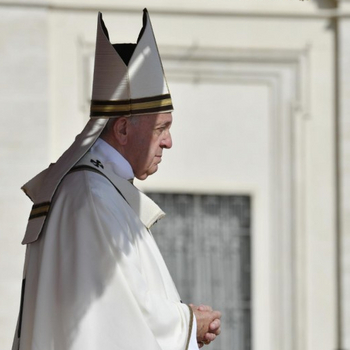
Pope Francis at the canonisation of Marguerite Bays
The canonisation in pictures
Beatification of Margaret Bays
Pope John Paul II beatified Marguerite Bays on 29 October 1995 in Rome. She was thus recognised as Blessed Marguerite Bays.

Pope John Paul II at the beatification of Marguerite Bays

